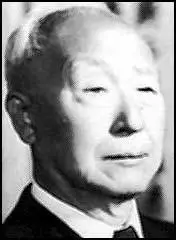Syngman Rhee

Syngman Rhee was born in Kaesong, Korea, on 26th April, 1875. He took an interest in politics and in 1897 he was imprisoned by the Yi Dynasty for taking part in a protest against the monarchy.
After his release in 1905 his education in the United States. Rhee eventually received a Ph.D from Princeton University in International Law. In 1919 he was elected president of the Korean Provisional Government in exile.
American and Soviet troops entered Korea after the defeat of Japan at the end of the Second World War. The country was divided at the 38th parallel and in 1948 the Soviet Union set up a People's Democratic Republic in North Korea. At the same time the United States helped establish the Republic of South Korea.
After the Second World War Rhee returned to Korea. Over the next two years Rhee emerged as the main right-wing politician in Korea and in 1947 he received the unofficial support of the United States government.
In 1948 Rhee became the first president of South Korea. He soon developed a reputation for authoritarian rule and his political opponents were quickly silenced.
In June 1949 the United States Army began to withdraw from South Korea. Statements made by General Douglas MacArthur and Dean Acheson suggested that the United States did not see the area as being of prime importance. Acheson argued that if South Korea was attacked: "The initial reliance must be on the people attacked to resist it and then upon the commitments of the entire civilized world under the Charter of the United Nations."
Kim Il-Sung, the communist dictator of North Korea, became convinced that the people in the south would welcome being ruled by his government. At dawn on 25th June 1950, the North Koreans launched a surprise attack on South Korea. Three days later, communist forces captured the South Korean capital, Seoul.
The Security Council of the United Nations recommended that troops should be sent to defend South Korea. As the Soviet Union was boycotting the Security Council at the time, it was unable to veto this decision. Fifteen nations sent troops to Korea, where they were organized under the command of Douglas MacArthur.
The surprise character of the attack enabled the North Koreans to occupy all the South, except for the area around the port of Pusan. On 15th September, 1950, Douglas MacArthur landed American and South Korean marines at Inchon, 200 miles behind the North Korean lines. The following day he launched a counter-attack on the North Koreans. When they retreated, MacArthur's forces carried the war northwards, reaching the Yalu River, the frontier between Korea and China on 24th October, 1950.
Harry S. Truman and Dean Acheson, the Secretary of State, told MacArthur to limit the war to Korea. MacArthur disagreed, favoring an attack on Chinese forces. Unwilling to accept the views of Truman and Acheson, MacArthur began to make inflammatory statements indicating his disagreements with the United States government.
MacArthur gained support from right-wing members of the Senate such as Joe McCarthy who led the attack on Truman's administration: "With half a million Communists in Korea killing American men, Acheson says, 'Now let's be calm, let's do nothing'. It is like advising a man whose family is being killed not to take hasty action for fear he might alienate the affection of the murders."
In April 1951, Harry S. Truman removed MacArthur from his command of the United Nations forces in Korea. McCarthy now called for Truman to be impeached and suggested that the president was drunk when he made the decision to fire MacArthur: "Truman is surrounded by the Jessups, the Achesons, the old Hiss crowd. Most of the tragic things are done at 1.30 and 2 o'clock in the morning when they've had time to get the President cheerful."
While this conflict was taking place in the United States, the Chinese government sent 180,000 men to North Korea. This back-up enabled North Korean forces to take Seoul for a second time in January 1951. U.N. troops eventually managed to halt the invasion sixty miles south of the 38th parallel. A counter-offensive at the end of January gradually recovered lost ground.
Once in control of South Korea, representatives of the United Nations began peace talks with the North Korean government on 8th July 1951. An armistice agreement, maintaining the divided Korea, was signed at Panmunjom on 27th July 1953.
Syngman Rhee remained in power after the Korean War. Over the years his regime was seen as authoritarian, corrupt and inefficient. He was re-elected in 1956 and 1960 by large majorities. However, few believed the elections had been fair and gave rise to widespread anti-government demonstrations.
A student uprising toppled Rhee's government in April 1960. Syngman Rhee escaped to Hawaii where he remained until his death on 19th July, 1965.
